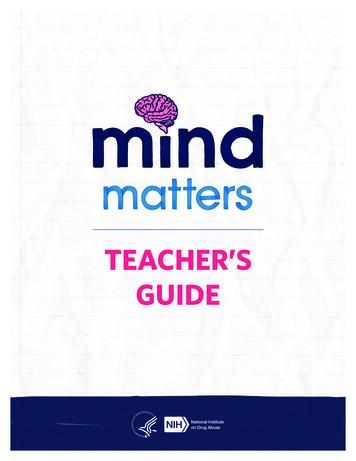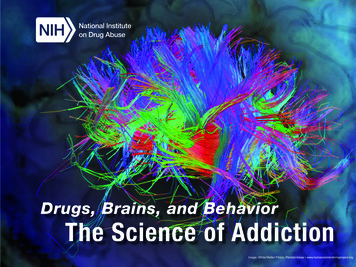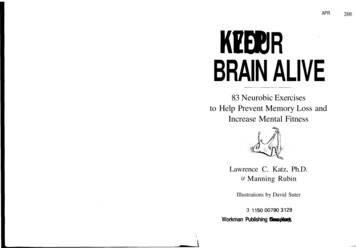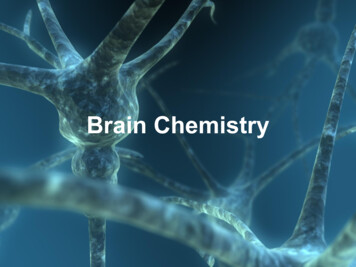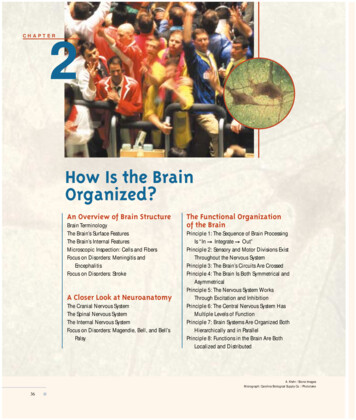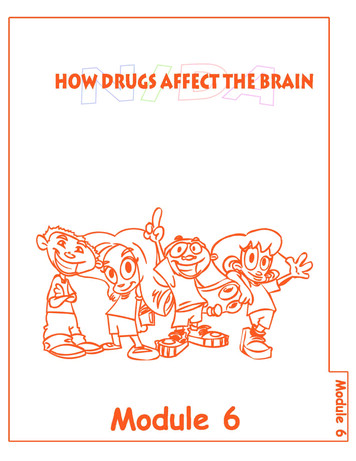
Transcription
0Module 6c.c-"
NIDA Junior Scientists ProgramModule 6Guide to Module 6:How Drugs Affect the BrainIntroductionStudents are nearing the end of the Brain Power! program. Over the last five modules,students have learned how to use scientific inquiry to perform experiments (modules1 and 5), how to identify the parts of the brain and their functions (module 2), whatneurotransmission is (module 3), the difference between medicines and harmful drugs(module 4), and the effects nicotine has on the brain and the body (module 5). Thisfinal module serves as a culminating activity and as an embedded assessment for theentire program. Using the information provided on four fact sheets, along with their priorknowledge, students will explain how cocaine, marijuana, alcohol, and nicotine affect thebrain and the rest of the nervous system. Students may use the model of the brain, theneurotransmission simulation they performed, or any other activity—such as putting on aplay, making a poster, or developing a comic strip—to explain their ideas.Learning Objectives Students review information about four drugs—cocaine, marijuana, alcohol, andnicotine.Students apply what they have learned in the previous modules to explain how thesedrugs affect the brain and the rest of the nervous system.Students present their findings to members of their class.Relationship to the National Science Education StandardsThis mission aligns with the following two standards identified in the NSES: science asinquiry and science in personal and social perspectives. The chart that follows identifieshow the mission aligns with each of these standards.6-1
NIDA Junior Scientists ProgramModule 6SCIENCE AS INQUIRYLevels K–4How Mission is AlignedAbilities necessary to do scientific inquiryStudents experience some of the steps inthe process of scientific inquiry: developing ahypothesis, completing an investigation to testthe hypothesis, and drawing conclusions.SCIENCE IN PERSONAL AND SOCIALPERSPECTIVESLevels K–4How Mission is AlignedPersonal healthStudents observe the effects that four drugshave on the brain and the nervous system.They discuss the impact this information hason their lives and how they can use it to makewise decisions about their own health.BackgroundBackgroundDifferent drugs have various effects on the body. People are motivated to take drugsbecause of the feeling of euphoria they experience as the drugs change the way the brainnormally works. Some of the changes that happen in the brain following drug use are shortterm, while other changes can last a long time.Prolonged drug use can change the brain so that addiction results. Addiction is a diseasecaused by changes in the structure and functioning of the brain. Addiction is characterized by: A strong compulsion or drive to use drugs despite negative consequences (someonekeeps using drugs even though he or she is having problems); Loss of control over amount of the drug used (using more than he or she plans) andover drug-related behavior (someone does or says things he or she would notordinarily do);6-2
NIDA Junior Scientists Program Module 6Intense craving for the drug when it is not available. This craving is due to changesin the brain. Once a person is addicted, he or she must have the drug just tokeep from feeling bad. This is because drugs can cause changes in the functioningof neurotransmitters in the brain.When a person stops using a drug, it takes a while for the brain to get back to normal.During that time, the person may feel bad and have intense craving for the drug. Researchin animals and some humans is beginning to suggest that some drugs may cause changesthat are permanent. Addiction is considered a disease because the drugs have changedthe normal functioning of the brain. Addiction can be successfully treated. However, thebest way to avoid addiction is to never start using drugs.CocaineCocaine is a stimulant made from the leaf of the coca plant. Cocaine speeds up activity inthe brain and the spinal cord, causing an increase in blood pressure and heart rate and adecrease in the flow of blood and oxygen to the heart. When someone snorts, injects, orsmokes cocaine, it travels to the brain very quickly. It reaches all areas of the brain but hasits greatest effects in the front part of the cerebral cortex and on part of the limbic system.A very complicated process takes place in the brain after it is exposed to cocaine. In anormal brain, the neurotransmitter dopamine is released by neurons to carry messagesin the limbic system. After the message has been carried to the next neuron, dopamineis reabsorbed from the synapse back into the neuron that released it. Cocaine blocksthe reabsorption of dopamine, leaving too much dopamine in the synapse. The excessdopamine is what causes the pleasurable feelings associated with taking cocaine and theincreased motor activity seen with higher doses.After a person abuses cocaine for a while, the brain tries to compensate for the excessdopamine, and the normal processes that take place are disrupted. The brain will no longerfunction normally without cocaine.6-3
NIDA Junior Scientists ProgramModule 6MarijuanaMarijuana is the dried leaves and flowers of the cannabis plant. More than 400 chemicalscan be found in the average cannabis plant. The active ingredient in marijuana thatproduces changes in brain messages is called tetrahydrocannabinol (THC). The brain hasreceptors for a specific chemical, anandamide, which is naturally produced by the brain.THC is able to attach to and activate these same receptors. These receptors are calledTHC receptors rather than anandamide receptors because scientists knew that THCattaches to these receptors long before anandamide was discovered.Scientists know less about how marijuana affects the nervous system than they do aboutother drugs. However, scientists know that some areas of the brain have a lot of THCreceptors, while other areas have very few or none. When a person uses marijuana, thechemicals in the drug travel through the bloodstream and attach to the THC receptors,activating them and interfering with normal neurotransmission.The areas of the brain with the most THC receptors are the cerebellum, the cerebral cortex,and the limbic system. This is why marijuana affects thinking, problem solving, sensoryperception, movement, balance, and memory.AlcoholAlcohol is found in beer, wine, and spirits, e.g., gin, vodka, or whiskey. It affects the brainand almost every other organ in the body. The parts of the brain affected by alcohol are thecerebral cortex, limbic system, and brain stem. Alcohol interferes with messages carried bymany neurotransmitters in the brain. Because these neurotransmitters are found throughoutthe brain, alcohol affects many functions, including thinking, coordination, and emotions.If a person becomes addicted to alcohol, he or she might be diagnosed with the diseaseknown as alcoholism. Alcoholism can be life-threatening. The long-term use of alcoholresults in the depletion of certain vitamins and minerals in the body. These deficiencies canresult in diseases like Wernicke-Korsakoff syndrome, a disease that affects the short-termmemory and, in some cases, can result in a permanent loss of memory.6-4
NIDA Junior Scientists ProgramModule 6NicotineNicotine comes from tobacco leaves and is found in all tobacco products—cigarettes,cigars, pipe and chewing tobacco, and snuff. Nicotine acts on the central and peripheralnervous systems. It also causes an increase in blood pressure, heart rate, and respiration.Nicotine is shaped like the neurotransmitter acetylcholine, which is involved in movement,breathing, heart rate, learning, and memory. When nicotine gets into the brain, it hooks ontothe place where acetylcholine would normally go and overexcites the brain.Nicotine also affects the neurotransmitter dopamine. Scientists think that nicotine’s effectson dopamine are what cause the pleasurable sensations smokers experience. The longterm effects of smoking include lung cancer, emphysema, heart disease, and addiction. Thelonger a person smokes, the harder it is to quit. Fewer than 1 in 10 people who try to quitsmoking actually succeed.6-5
NIDA Junior Scientists ProgramModule 6The chart below summarizes the effects that these four drugs have on the brain and body.DrugEffects on the Brain and BodyParts of the Brain AffectedCocaine(1) Increase in blood pressure and heart rate(2) Change in emotional behavior(3) Impaired thinking and decision making(1) Brain stem(2) Limbic system(3) Cerebral cortexMarijuana(1) Short-term memory loss(2) Impaired thinking and problem solving(3) Impaired movement(1) Limbic system(2) Cerebral cortex(3) CerebellumAlcohol(1) Impaired thinking and problem solving(2) Change in emotional behavior(3) Impaired coordination(1) Cerebral cortex(2) Limbic system(3) CerebellumNicotine(1) Increase in respiratory rate and blood pressure(2) Increases the amount of the neurotransmitterdopamine present in synapses(1) Brain stem(2) Limbic system6-6
NIDA Junior Scientists ProgramModule 6MaterialsNIDA Junior Scientists DVDFact sheetsBrain model (from module 2)Student instruction sheet (from module 3)Riddles (from module 4)Log sheetsTrading cardsPaper and pencilsPreparation1. Divide the class into groups of three for this activity.2. Make one copy of the fact sheets, the instruction sheet, and the log sheet for eachstudent.3. Make sure you have the materials from the first five modules available for thisactivity. These include the students’ models of the brain, the instruction sheets fromthe previous modules, the log sheets from the previous modules (in each student’sportfolio), and the riddles from module 4. Lay out the materials on a table so thatyou can refer to them during the activity.It may take students more than one classperiod to complete this activity.6-7
NIDA Junior Scientists ProgramModule 6Procedure1. From the previous modules, point out the materials on the table. Briefly discuss thehigh points of each module, which include: the parts of the brain, neurotransmission,the difference between helpful and harmful drugs, and what tobacco does to thebody. Tell the students that they are going to draw some conclusions about whatthey have learned during the Brain Power! program and to apply that knowledgeto substances they did not study. Ask students if they remember what the first stepis in scientific inquiry. Help the class remember that the first step is to observe anddescribe these materials.2. After the class shares its ideas, tell students to get into groups of three. Have eachgroup develop conclusions based on all they have learned during the program.Then have each student record his or her group’s conclusions on the log sheet.For example, one possible conclusion may be: “It is important to take care of yourbrain by not putting unnecessary drugs into your body.” Each group’s conclusionshould emphasize the importance of not taking any substance that could harm theway the brain and the nervous system work. Have each group use the informationin the previous modules to explain why they shouldn’t put unnecessary drugs intotheir body.3. Now give students an opportunity to apply what they learned to two newsubstances. Give half the groups the fact sheets about cocaine and alcohol andhalf the groups the fact sheets about marijuana and nicotine. Tell students that theirmission is to determine how these drugs affect the brain and the nervous system.Then students will have an opportunity to present their ideas to the class. Theirpresentations can use the model of the brain, the neurotransmission simulationgame, or the riddles. They also can develop a skit, make a poster, write a comicstrip, or develop their own unique presentation.6-8
NIDA Junior Scientists ProgramModule 64. CONGRATULATIONS! YOUR STUDENTS HAVE JUST COMPLETED THE LASTMODULE IN THE BRAIN POWER! PROGRAM.When your class has completed the Brain Power! program, place the reversesides of all six posters together to create the certificate of completion. Thestudents can all sign their names to indicate that they are now NIDA JuniorScientists!6-9
NIDA Junior Scientists ProgramModule 6Discussion Questions1. Have each group give its presentation. After the presentations, discuss how cocaine,marijuana, alcohol, and nicotine affect the brain and the nervous system.2. Have each student summarize what he or she learned during the Brain Power! program.Ask each student to read his or her summary to the class.3. Ask students to think of one thing they would tell their friends and family about the program.Suggest that they make a poster of their one thought and share it with their families.ExtensionsThe activities listed below provide links to other areas in the curriculum. These activitiesalso make use of the trading cards included in the module.LanguageartsArtReadingMathScienceDrama1. Put out the trading cards from all six modules. Have the students look themover and think about other ideas for cards. Then ask each student to createone new trading card on a subject relevant to the Brain Power! program.2. Have the students imagine that a good friend has just started smoking. Askthe students to decide what they would say to their friend to convince him orher to stop smoking. Then ask for volunteers to act out the scene.6-10
NIDA Junior Scientists ProgramModule 6AssessmentThis lesson is an embedded assessment of what students have learned throughoutthe Brain Power! program. As students work, observe whether they have mastered thefollowing:1. Can each student develop conclusions that reflect the work done in the modules?2. Can groups of students apply what they have learned about a substance to its effect onthe brain and the nervous system?3. Are students approaching the task logically and methodically?4. Are students able to synthesize the information to create a presentation that is engagingand accurate?5. Are students able to summarize what they did and develop a clear, crisp statementexpressing their conclusions about the program?6-11
NIDA Junior Scientists ProgramModule 6Additional ActivitiesBelow are some additional activities that can be used after completion of the sixth mission.These activities are extensions to many other areas of the curriculum.1. Develop a board game showing how drugs affect the brain and the nervoussystem. The object of the game could be to match the drug with the partof the body it affects, or to solve problems using the processes of scientificinquiry.2. Develop or identify a new scientific question or problem and then use theprocesses of scientific inquiry to solve it. For example, the problem could be howfast your heart beats before and after exercise, or how your tongue knows howdifferent foods taste. Encourage your students to design their own experiments.3. Build a more complex model of the brain than the one built in module 2. Usescience books or Web sites to find a model. Then use clay or other materialsto make a more anatomically detailed model.4. Write a play summarizing what you have learned about drugs. The play couldfocus on different drugs and what they do, how drugs affect the brain and thenervous system, or why smoking is a bad habit to start. The students maywant to invite other classes in the school to see their play.6-12
NIDA Junior Scientists ProgramModule 6ResourcesThe lists below include resources for teachers and students.Resources for TeachersNational Institute on Drug Abuse (NIDA)www.drugabuse.gov, 301-443-1124This Web site contains information about drug abuse and a section designed specifically forparents, teachers, and students.NIDA Drug Pubsdrugpubs.drugabuse.gov, 1-877-NIDA-NIH (1-877-643-2644)Drug Pubs is NIDA’s research dissemination center. Visitors can order hard copies of NIDApublications or download electronic versions in multiple formats.Sara’s QuestThis site from NIDA contains a multiple choice game on a variety of drug related pNational Clearinghouse for Alcohol and Drug Information (NCADI)http://store.samhsa.gov, 1-800-729-6686NCADI provides information and materials on substance abuse. Many free publications areavailable here.6-13
NIDA Junior Scientists ProgramModule 6Eisenhower National Clearinghouse (ENC)www.goenc.com, 1-800-471-1045This Web site provides useful information and products to improve mathematics and science teaching and learning.Bellenir, K., ed. Drug Abuse Sourcebook. Health Reference Series, Omnigraphics, Inc.,2010. Basic health-related information about the abuse of legal and illegal substances suchas alcohol, tobacco, marijuana, and cocaine.Greenfield, S.A. The Human Brain: A Guided Tour. New York: Basic Books, 1998. Writtenfor a lay audience, provides a holistic view of the brain as an integral part of the body; partof the Science Masters Series.Resources for StudentsNational Institute on Drug Abuse (NIDA)—Mind Over es developed to educate children about the effects of drug abuse on the body and thebrain.Friedman, D., & Neuhaus, D. Focus on Drugs and the Brain. Frederick, MD: Twenty-FirstCentury Books, 1990. Part of the “Drug-Alert Book” series. Describes the function of thebrain and nervous system and how drugs affect the body.Neuroscience for tmlExplores the brain and spinal cord; lists the effects of drugs on the brain and nervoussystem.6-14
Student Instruction SheetModule 6: How Drugs Affect the Brain1. It’s time to pull all your ideas together and figure out exactly what you learned abouthow different drugs affect the brain.2. Look at all the materials laid out on the table. They are from the first five modules youworked on. Begin by observing the materials and describing them. Then discuss thehigh points of each module with the class.3. Your teacher will assign you to a group. With your teammates, develop a fewconclusions that bring together what you learned during the Brain Power! program. Ifyou need some ideas, your teacher can give you an example. Then write your group’sconclusions on your log sheet.4. Now see if your knowledge of the brain can be applied to materials you did not study.Your teacher will give half the groups fact sheets on cocaine and alcohol, and half thegroups fact sheets on marijuana and nicotine. Your mission is to figure out how thesedrugs affect the brain and the nervous system. See if what you find out supports yourconclusions about what you have learned.5. After learning about the new substances, think about how to present your ideas to theclass. You may use your model of the brain or the neurotransmission simulation game.Perhaps your group would like to develop a skit, make a poster, or write a comic strip.Anything goes! Have fun, and focus on something interesting and original. Make sureyou tell the class whether your research proved or disproved your conclusions.
6. When it’s your group’s turn, give your presentation to the class. Then discuss howcocaine, marijuana, alcohol, and nicotine affect the brain and the nervous system.7. There’s one more thing to do. If you could tell your family and friends one idea about theBrain Power! program, what would it be? Write down your thoughts in a paragraph ordescribe them on a poster.8. CONGRATULATIONS! YOU HAVE JUST COMPLETED THE LAST MODULE IN THEBRAIN POWER! PROGRAM.Put the last piece in the puzzle poster to receive your diploma.
Fact SheetCocaineCocaine affects many different parts of the brain, including the brain stem, limbic system,and cerebral cortex. Cocaine makes the heart beat faster and makes blood pressure go up.It can change the way someone feels and acts. It also makes it harder for people to makesmart decisions. Cocaine changes the way neurons talk to each other. It fools the braininto thinking there’s too much of the neurotransmitter dopamine, so the brain doesn’t makeas much dopamine as it should. Then there isn’t enough dopamine in the brain, and theneurons need cocaine to work correctly. Cocaine is a very addictive drug, so when peopleuse it, they often find it really hard to stop.Think about . . .1. What parts of the brain and nervous system do cocaine affect?2. How could you use your model of the brain to show how cocaine affects the brain?3. How could you use your neurotransmission model to show how cocaine affectscommunication?4. What kind of poster could you make to show how cocaine affects the brain?5. If you could write one message about the dangers of cocaine, what would it be?
Fact SheetMarijuanaMarijuana affects several parts of the brain, including the limbic system, cerebral cortex,and cerebellum. Marijuana can make it harder to remember things, think clearly, and solveproblems. It also changes the way neurons talk with each other. Marijuana can also havesome negative effects on health. When a person uses marijuana, he or she increases therisk of harming the lungs. Marijuana is an addictive drug that changes the way the brainfunctions. Once the brain has been changed by marijuana, it may not work normally withoutit.Think about . . .1.2.3.4.What parts of the brain does marijuana affect?How could you use your model of the brain to show how marijuana affects the brain?How could you act out how marijuana affects the brain?If you could write one message about marijuana, what would it be?
Fact SheetAlcoholAlcohol affects many parts of the brain, including the brain stem, cerebral cortex, and limbicsystem. Alcohol makes it harder to think clearly and remember things. It blocks messagesgoing to the brain from other neurons, and it interferes with balance. It also changes theway someone feels and acts. After consuming alcohol over a long period of time, a personmay start to need it to keep from feeling bad. When that happens, the person most likelyhas a disease called alcoholism.Think about . . .1. What parts of the brain and nervous system does alcohol affect?2. How could you use your model of the brain to show how alcohol affects the brain?3. How could you use your neurotransmission model to show how alcohol affectscommunication?4. If you could write one message about alcohol, what would it be?
Fact SheetNicotineNicotine affects several parts of the brain, including the brain stem and limbic system.It causes the heart to beat faster and the lungs to work harder. It also affects theneurotransmitters acetylcholine and dopamine. Scientists think that nicotine’s effect onthese neurotransmitters causes addiction to nicotine. Smoking is a good habit to avoidbecause it can cause many serious diseases, including cancer and heart disease. Formany people, it’s very difficult to stop smoking once they’ve started.Think about . . .1. What parts of the brain and the nervous system does nicotine affect?2. How could you use your model of the brain to show how nicotine affects the brain?3. If you could write one message about nicotine, what would it be?
NIDA Junior Scientists ProgramModule 6If you do not have a DVD player, read this storyto your class to introduce the mission.Introductory Story for Module 6“I don’t know about you, Brain Trust, but my head is spinning,” said Brain Wave.“What do you mean?” replied Brain Trust.“We’ve learned so much in such a short period of time. First, we learned about the brain andeverything it does. Then we learned about how messages are sent throughout the body. And that’sjust the beginning!”“I guess you’re right,” said Brain Trust. “Then we moved on to find out about medicines, drugs, andnicotine. It has been a lot. No wonder your head is spinning.”“What can we do to make sense of it all?” asked Brain Wave.“Well, those steps of scientific inquiry could help,” suggested Brain Trust. “You know, observe,hypothesize, experiment, and conclude.”You’re right. We could try to figure out what all these different ideas have in common,” said BrainWave.Just then, they heard the computer dinging, and they saw their trusty friend Corty on the screen.“Couldn’t help overhearing your conversation. What do all these ideas have in common? How canwe use the steps of scientific inquiry to put all of the modules together? ” Corty said.Brain Wave and Brain Trust looked at each other. They weren’t sure. What do you think? Can youcome up with a way to tie all this information together? Talk to your classmates. By figuring out thelast problem of the NIDA Junior Scientists Program, you become a member of the club. Good luck,and may the tools of science be with you.6-21
Log SheetYour group’s observationsYour group’s conclusionsYour group’s presentationName:
BRAIN POWER NEWSVolume 1, Number 6Parent NewsletterHow Drugs Affect the BrainYour child is nearing the end of the Brain Power! science program. Over the last fivemodules, your child has learned how to use scientific inquiry to perform experiments,how to identify the parts of the brain and their functions, what neurotransmissionis, the difference between medicines and harmful drugs, and the effects of nicotineand tobacco on the brain and the body. During the last module, your child had anopportunity to learn about how four substances—cocaine, marijuana, alcohol, andnicotine—affect the brain and the rest of the nervous system.To help students complete this task, they received fact sheets about two of thefour substances. For your reference, this information is summarized below.DrugEffects on the Brain and BodyParts of the Brain AffectedCocaine(1) Increase in blood pressure and heart rate(1) Brain stem(2) Change in emotional behavior(2) Limbic system(3) Impaired thinking and decision making(3) Cerebral cortex(1) Short-term memory loss(1) Limbic system(2) Impaired thinking and problem solving(2) Cerebral cortex(3) Impaired movement(3) Cerebellum(1) Impaired thinking and problem solving(1) Cerebral cortex(2) Change in emotional behavior(2) Limbic system(3) Impaired coordination(3) CerebellumMarijuanaAlcoholNicotine(1) Increase in respiratory rate and blood pressure (1) Brain stem(2) Increases the amount of the neurotransmitterdopamine present in synapses(2) Limbic systemcontinued
Our goal in introducing this material is to provide scientific information aboutthe effects of drugs on the body. By presenting the material to students whenthey are still young, we hope to lay a foundation upon which they can build ideasas they grow. We also hope that their early exposure to this information will helpthem make healthful choices about drugs in the future. We encourage you todiscuss these issues with your child. Ask your child what he or she learned fromthe program. What overall impressions has he or she brought away from the BrainPower! program?Science at HomeAt school, your child was asked to write down one message that he or she wouldconvey to family and friends after completing the Brain Power! program. Try thisactivity as a family. What is one message about the brain and drugs that your family wouldlike to convey to others? Then send the message on to a friend and ask him or her to spreadthe word. Friends and family members are influential people in children’s lives. We believe themore people repeat the message about the harmful effects drugs can have, the clearer themessage will be for children.What Does Your Child Think?Have your child draw or write something about how drugs affect the brain.Additional ResourcesThe books and Web sites listed below have more information about drugs.National Institute on Drug Abuse (NIDA)www.drugabuse.gov, 301-443-1124This Web site contains information about drug abuse anda section designed specifically for parents, teachers, andstudents.National Clearinghouse for Alcohol and Drug Information(NCADI)http://store.samhsa.gov, 1-800-729-6686NCADI provides information and materials on substanceabuse. Many free publications are available here.NIDA Drug Pubsdrugpubs.drugabuse.gov, 1-877-NIDA-NIH(1-877-643-2644)Drug Pubs is NIDA’s research dissemination center. Visitorscan order hard copies of NIDA publications or downloadelectronic versions in multiple formats.Bellenir, K., ed. Drug Abuse Sourcebook. Health ReferenceSeries, Omnigraphics, Inc., 2010. Basic health-relatedinformation about the abuse of legal and illegal substancessuch as alcohol, tobacco, marijuana, and cocaine.National Institute on Drug Abuse (NIDA)—Mind Over Matterwww.nida.nih.gov/MOM/MOMIndex.htmlSeries developed to educate children about the biologicaleffects of drug abuse on the body and the brain.Friedman, D. Focus on Drugs and the Brain. Frederick,Maryland: Twenty-First Century Books, 1990. This book,part of the “Drug-Alert Book” series, includes a section oneach drug of abuse and addiction.Neuroscience for This site includes a section on the history of tobacco,cigarette smoking, nicotine addiction, and the effect ofnicotine on the brain.
StimulantsCocaineCaffeineNicotineStimulants are a group of drugsthat excite the neurons in thebrain. Stimulants speed up activityin the brain. Some stimulants arevery addictive, such as cocaine andnicotine. Caffeine is also a stimulant.Caffeine is usually not dangerouswhen used carefully.mod6-1 tc.aiDepressantsSedativesAlcoholDepressants are a group of drugsthat slow down the activity inthe brain and body. Depressantsimpair thinking and memory. Regularuse of these drugs can lead toaddiction. Alcohol is the mostcommonly used depressant.
NeurologistA neurologist is a doctor who cares forthe nervous system, including all theneurons and nerve pathways in your body.You can go to this doctor if you need helpfor brain or nerve diseases. Neurologistswork in hospitals, offices, and clinics.There are special neurologists justfor kids.mod6-2 tc.aiBrain Powerhas taught us manyimportant things about science. We knowthat we can all be scientists by using theprocess of scientific inquiry. We haveal
It reaches all areas of the brain but has its greatest effects in the front part of the cerebral cortex and on part of the limbic system. A very complicated process takes place in the brain after it is exposed to cocaine. In a normal brain, the neurotransmitter dopamine is re




